Get an Extreme Tribal Makeover at the Yawanawá Festival
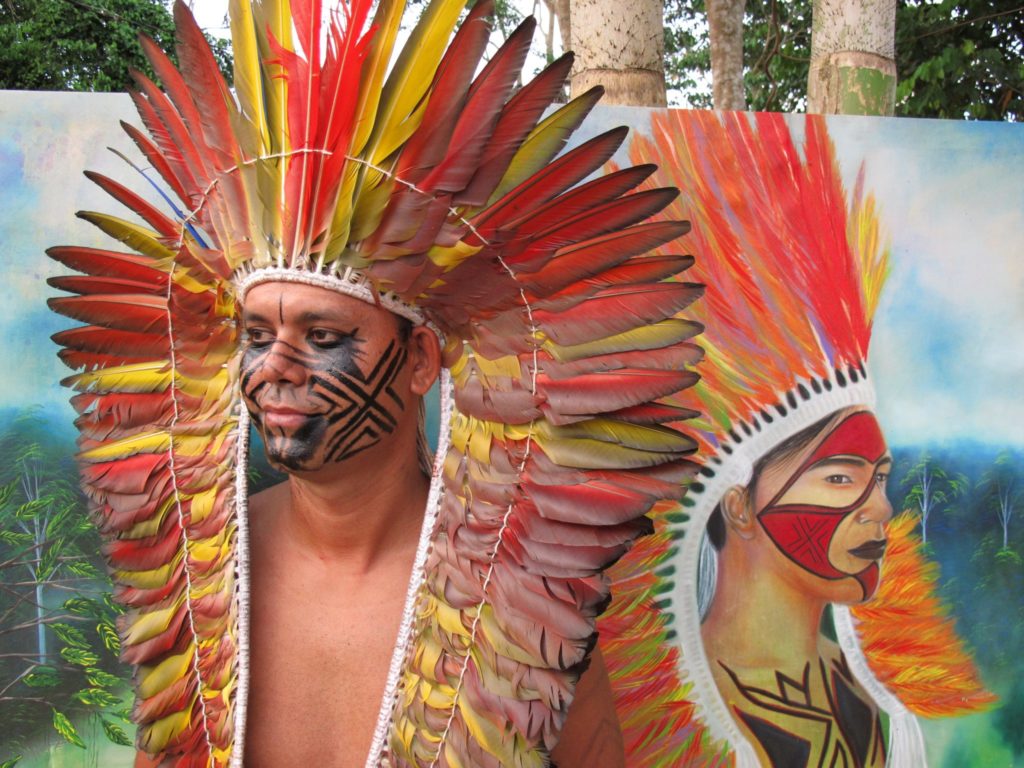
Tribal festivals are a great way to immerse yourself in the indigenous culture of the Amazon Basin. Tribes like the Yawanawá, Huni Kui and the Kuntanawa in the state of Acre, Brazil, like to host festivals and welcome outside visitors. Festivals like these are the fantastic events to attend because you get to see and participate in tribal dances, get an extreme tribal makeover, attend nightly ayahuasca ceremonies, and experience full on tribal life in an otherwise sleepy village.
Not only will this be a memorable, potentially life-changing experience, life in the jungle will completely change your worldview, and quite possible reset your priorities. When you realize how difficult it is to survive in the jungle, and start developing an appreciation for the vast knowledge your indigenous friends have about the plants and animals in their forest home, it will make your office drama seem completely insignificant.
Staying for any period of time in the Amazon jungle requires a certain level of preparation in order to optimize your comfort and enjoyment of your experience. Because, in the Amazon, it is hot, humid and everything is trying to eat you.
Here’s a practical guide to visiting indigenous villages and attending tribal festivals – like the Yawanawá Festival – in the Brazilian Amazon.
MUST READ Amazon Jungle Survival Guide – For Visiting Tribes in the Brazilian Amazon
A Word About Sensitivities Around Cultural Appropriation
Indigenous tribes all over the world have suffered genocide, enslavement, torture, and economic marginalization. These injustices continue to date in the North and in the South. Many indigenous people have strong feelings about cultural appropriation, with good reason, given their nations’ histories. Sensitivities around cultural appropriation are heightened in North America with the Standing Rock oil pipeline conflict currently ignited in South Dakota.
Having attended the 2013 Yawanawá Festival and being a frequent visitor to different tribes in the Brazilian Amazon, there appears to be less sensitivity around cultural appropriation, even though injustices against the indigenous people continue. My indigenous friends seem to love to dress their “nawa” friends up in tribal garb and paint their faces. They love it when non-indigenous friends get into their culture, and learn their songs. They will patiently try to teach you to shoot a bow and arrow, or fish in the river. If you are in the village, somebody, at some point, is going to want to paint your face.
One thing I can say is, if you do attend the Yawanawá Festival, you will be fully expected and encouraged to participate in tribal activities.
If you hang out in white people’s clothes and don’t get face or body painted, SOMEBODY – quite possibly the chief – is going to bug you to put on a grass skirt and get in the circle dance.
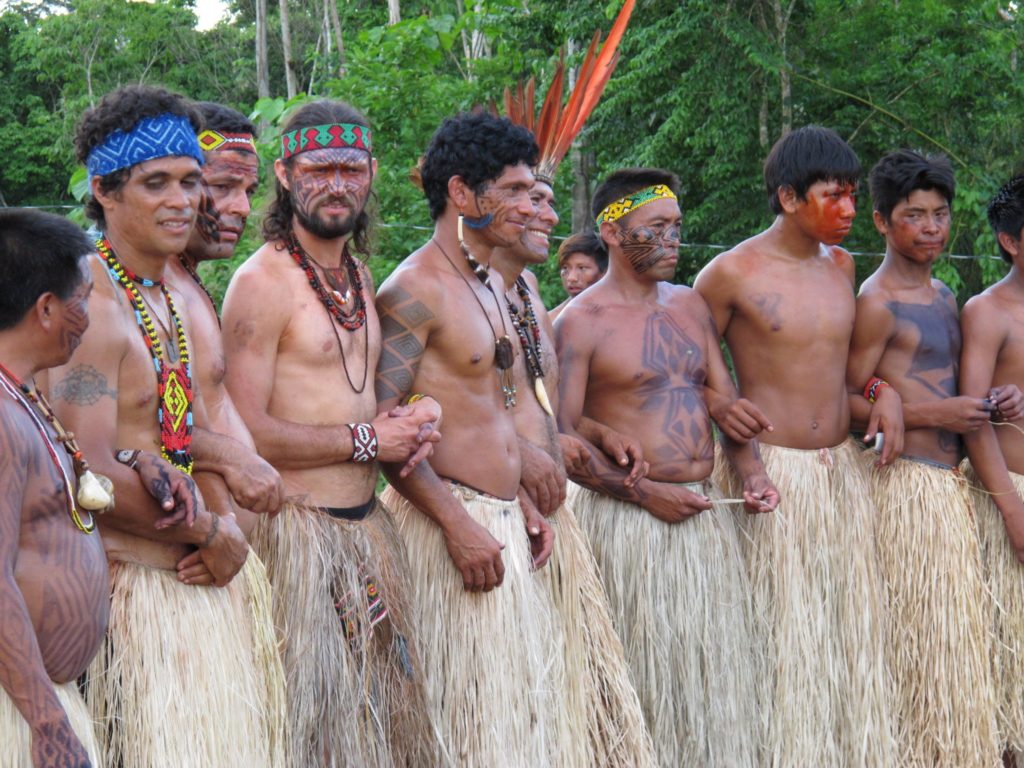
6 Not-to-Be-Missed Tribal Experiences
Attending a tribal festival is an immersion into tribal culture, where you get to experience the tribe’s dances, songs, and medicine. Here are some things to try at least once in your life.
1. Tribal Face-Painting & Semi-Permanent Body Tattoos
The Indians use 2 kinds of vegetable dyes for face and body-painting – urucum, and jenipapo. Urucum is a red paste that comes from Achiote (Bixa orellana) seed pods. This washes off.
The really cool tribal facepaint makeover you want is with a black dye made from the jenipapo (Genipa americana) fruit that is semi-permanent. It will stay on your body or face for 2 weeks.
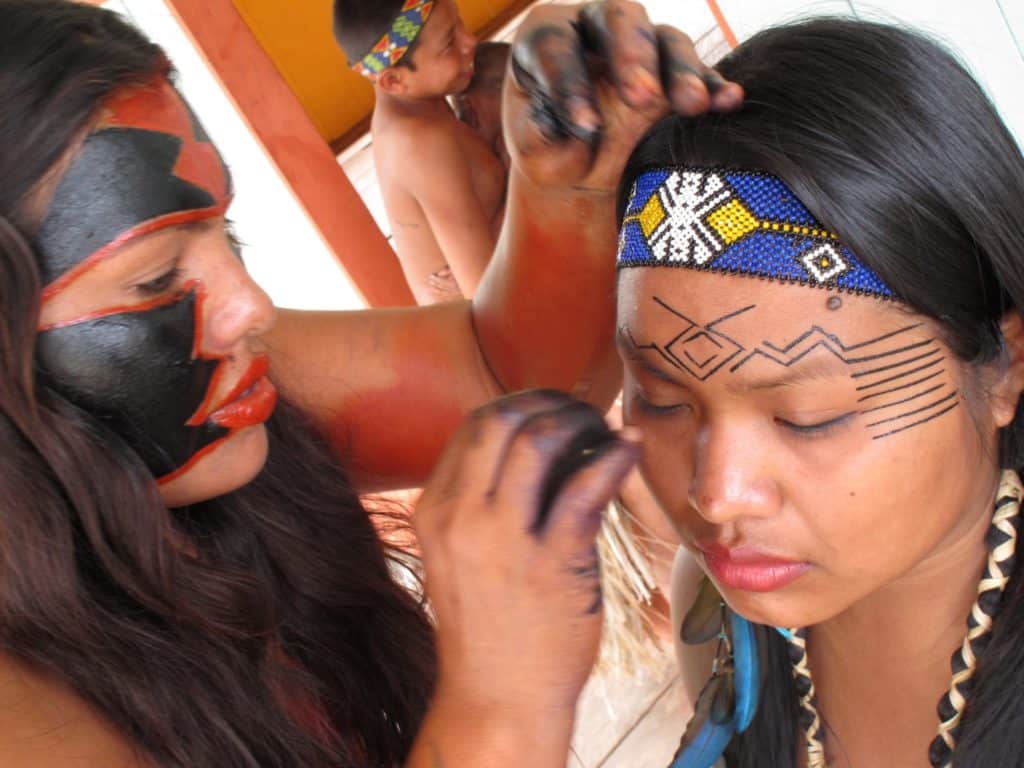
Here are some tips to make sure you have a totally badass tribal paint job.
- Let the dyes dry as completely as possible and try not to remember not to rub your face immediately afterwards or if you feel sweaty
- Opt for no genipapo under your nose, because this area tends to sweat a lot and anything painted here tends to get smeared and look like a mustache
- Let the genipapo dry on your face or body all day. The layer of paint will cake and crack off. After a few hours you can wash yourself and you will find that the color will actually darken on your skin. DO NOT use soap, or you will wash it off and it will fade more quickly.
- Avoid getting urucum on anything white. It will stain it forever.
2. Tribal Dancing
You are welcome to join in any and all dances, and discover what these dances mean to the tribe. Don’t forget your grass skirt.
3. Rapé – The Sacred Medicinal Snuff You Blow Up Your Nose
Rapé – pronounced ha-PAY – is a powdered medicinal snuff that the Indians take up the nose. The sharing of medicinal snuff is an indigenous practice that goes back to pre-Columbian times, and still takes place in all aspects of life, from formal ritual use in rites of puberty, initiation, festivals, to simply hanging out with friends.
Copious amounts of rapé are consumed at tribal festivals. It’s the primary reason the shamans are able to forego sleep and conduct 5 nights of ayahuasca ceremonies.
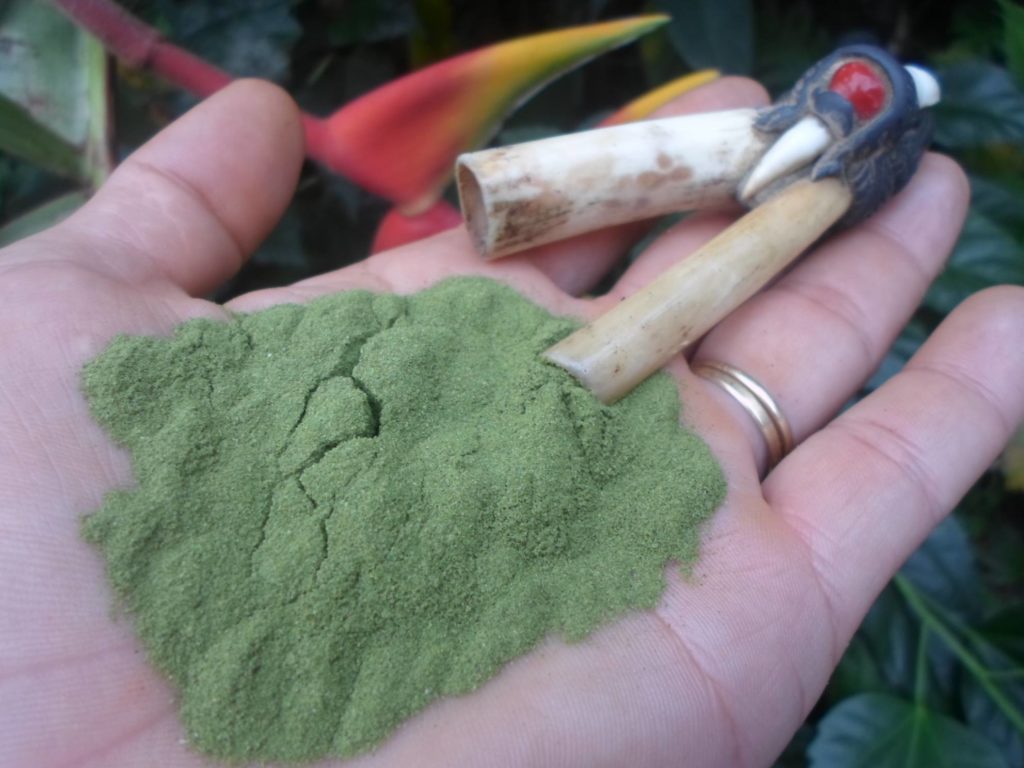
MUST READ Rapé – the Sacred Amazonian Snuff You Blow Up Your Nose
4. Ayahuasca Ceremony
Tribal festivals like the ones hosted by the Yawanawá, Huni Kui, Puyanawa and Kuntanawa will usually include ayahuasca ceremony at night. The ayahuasca ceremonies that the Yawanawá lead are a powerfully unforgettable experience because:
- The songs are beautiful and the entire tribe gathers to sing them.
- The elder shamans are amazing and full of energy. Yawa is over 100 years old and is the last one standing after an all night ceremony.
Sometimes ayahuasca is also drunk during the a festive daytime work, like this one:
MUST READ Everything You Need to Know About Ayahuasca
5. Kambô – the Hallucinogenic Tree Frog
Kambô is frog medicine from the Phyllomedusa bicolor tree frog, otherwise known as the “Giant Monkey Frog”. Kambô is a traditional Shamanic frog poison cleanse that is used to strengthen and heal mind, body and spirit, and is taken like the Amazonian version of a flu shot. It is mildly psychoactive and was traditionally used to heal sickness, invoke prescience in hunting (the Indians believed kambô would show you where your next meal was going to be), and to cure laziness in children.
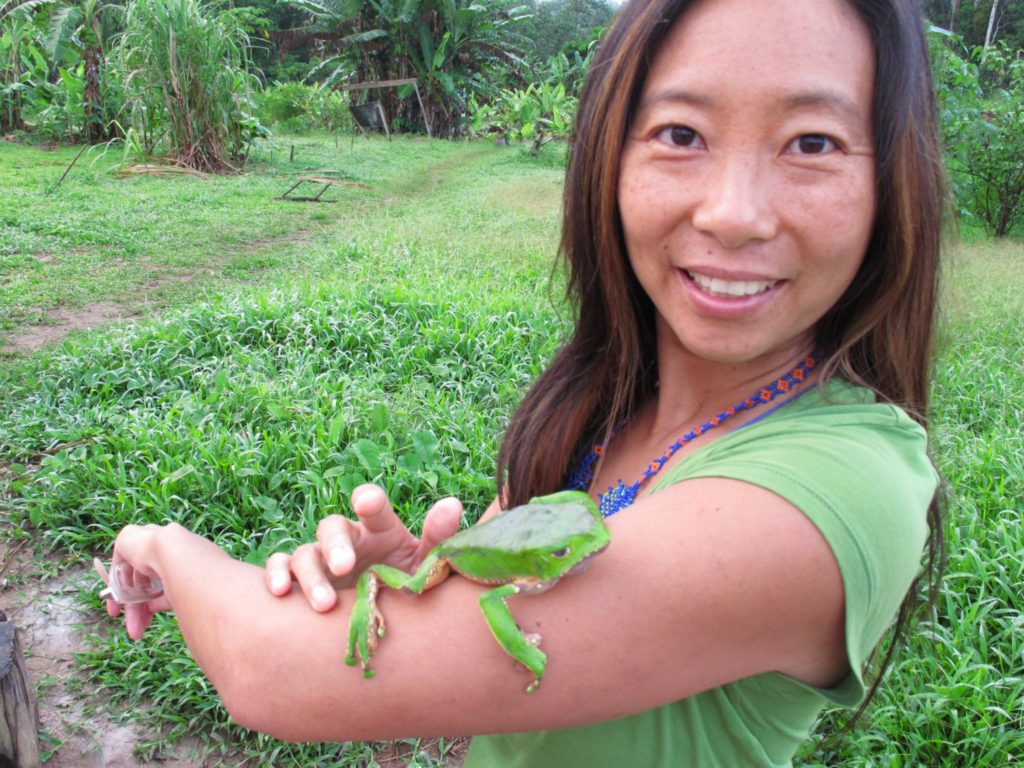
A shaman will burn the tip of a thin stick and then use it to burn points into your arm or ankle. He will then scratch the wound open with his fingernail and apply either the dried or fresh kambô medicine to the open wound, where it will enter your bloodstream. In a few minutes, you’ll feel the effect of the frog venom. It will make you projectile vomit. It will also make you want to purge out the other end. That’s the cleansing part. The goal is to get to the bile. Then the shaman will wash the venom off your skin, and you can clean yourself up.
Here are some tips to ensure a successful kambô cleanse:
- You will need to drink a lot of water or caiçuma (a fermented mandioca drink) before your kambô session in order to have something to projectile vomit out.
- If you are vomiting doubled-over (not sure of how to do this any other way), your face will swell up like a frog for 2-3 hours.
6. Jungle Walks
No visit to the tribal villages is complete without a long jungle hike, with a knowledgeable tribesman who will point out medicinal plants, identify jaguar paw prints, and have you forge rivers and streams. Wear Tevas.

Where You Will Be Staying
The village will construct a series of shelters with palm thatch roofs for outside visitors to pitch their tents or hang their hammocks. Jungle travel is best done with hammock. There are 2 main reasons.
The ants.
There are innumerable species of ants from really tiny to gigantic. All of them make trails that are like ant superhighways in the jungle that will stop at nothing to get to where they are going. The ant superhighways aren’t necessarily visible all the time, because sometimes the ants are hard at work somewhere else. But the ants know where it is based on their smell. If you happen to pitch your tent across an ant superhighway when there’s no traffic, and later the ants come back, they will chew through everything to get from point A to point B. Nothing, not even your gigantic tent will stop them. Your tent will have holes in it and you will have ants in everything.
The rain.
It can rain a lot in the jungle and when it does the ground can flood. If your tent is not completely weatherproof, everything on the floor of your tent will get wet.
Food & Water
You will be fed, and the food will be basic – beans, rice, macaxeira (yucca), boiled spaghetti noodles and meat. Food in the Amazon is really not that great. There isn’t enough game or home grown produce to feed all the visitors, so all of it must be bought. If you are a vegetarian, vegan, or raw foodist, you are shit out of luck unless you haul your own.
Clean drinking water is hard to come by. You will need to bring your own filtration or purification system because water standards in the villages are different. The Indians will drink straight out of the river, which causes dysentery and worms. If an Indian friend fills your water bottle, they might fill it straight from the river because that’s what they would drink. Some households have clay water cisterns with filters, but its questionable how often the filters get changed, because they have to buy them from town hours or days away by bought.
Many people, both Indians and Brazilians, underestimate how hot it gets and how hard it is to get to a clean water source, be it someone’s water cistern, the well water spigot, or spring. If you are a rugged American individualist you might find yourself annoyed by all the people who didn’t prepare themselves with enough water for the day, asking to drink your purified water that took a great deal of effort to procure and filter. Rather than say “No” and look like an asshole, refusing water to someone who is overheated and in need, you can say,
“I’m happy to share my water with you, but only if you go and fill it with water again after you are done.”
This request is best used with non-indigenous people who ought to be better prepared for hot tropical weather. Indians, being more communal in behavior, may not “get” your request, and if they do, may fill your bottle with the river water they drink themselves.
So if you don’t want people you don’t know drinking from your water bottle that you have visible in the on the outside of your backpack, and if you don’t want to get back to your backpack, only to find your liter bottle of water you walked half a mile to fill, completely empty, tuck it deep into the recesses of your bag.
Gifts for the Indians, and Gifting Protocol
The tribes have a gift-giving culture. You may be amazed at how someone you just met wants to give you something.
Here’s the deal.
When you receive a gift, you are expected to give something back. You might find that the person giving, isn’t giving in an unconditional way, they are giving it to get something from you. So show up with gifts and enjoy the exchange. Here are some tips for positive gift exchange:
- Try to gift based on exchange value or the strength of your relationship. A digital camera for a simple bead necklace is not an equal value gift and also creates distortions in the relationships between the Indians and outsiders, especially if your relationship with the necklace giver isn’t very strong. If you have a longstanding relationship with someone and their family, say, your indigenous friend hosted and fed you for weeks, then a higher value gift like a camera or laptop may be appropriate.
- Try not to give gifts that will exacerbate envy and discord in the villages. Some families have a stronger relationship with outsiders and they tend to get all the best gifts – computers, digital cameras, etc. This makes the other families who don’t have these relationships feel bad, and separates the village into the “haves” and “have-nots”. It also can create a handout mentality.
- Try not to give gifts that will end up as trash in the jungle, because the Indians don’t have a way to properly dispose of things made out of plastic that no longer work. Dead batteries only accumulate and end up in the bush or on the ground. They most certainly do not get recycled.
The Indians value long-lasting, utilitarian objects that make their lives easier in the jungle, and things they would otherwise not be able to afford.
High value gifts
- Good fold out knives for hunting & camping
- Solar powered lights
- Solar powered chargers
- Camping lights with rechargeable batteries
- Rechargeable batteries
- Digital cameras
- Laptops
- Attractive stainless steel water bottles.
- Attractive stainless steel storage containers.
- Dry bags.
- Sleeping bags
- Lightweight travel hammocks
- Jungle hammocks – with rainfly and bug screen.
Gifts for the shamans
- Bundles of white sage
- Aromatic herbs like copal or palo santo
- Organic leaf tobacco
- First aid kits and medicine.
Gifts for the women
- Beautiful rock crystals
- Beadwork beads. Get the right kind. Tiny, made of solid color plastic. Do not buy white beads with surface layer colors, because this rubs in a short amount of time and then the beautiful geometric patterns are ruined. Do not buy iridescent and metallic beads because they make traditional beadwork jewelry look weird.
- Clothes. Clothes cost money and the Indians are cash poor.
- Attractive tins of tea.

Things to Consider Buying
- Rapé and rapé applicators
- Artesenatos – handcrafts like weavings, ornaments and jewelry made of seeds
- Fruits and greens from someone’s private garden
- Laundry service. You can pay a villager to wash and hang your clothes dry. It’s worth it.
Definitely Do NOT Buy
- Anything made with bird feathers. Even though indigenous people are allowed to wear feather headdresses because it’s part of their cultural heritage, know that many rainforest birds are at risk or endangered. This includes harpy eagle, macaws, and king vultures.
- Anything made with rainforest animal skins.
- Ayahuasca. Really. Unless you really know who made it, how they made it, what’s in it, and the intent in which it was made, and you are an experienced medicine carrier – don’t buy ayahuasca. Most of the Brazilian Indians don’t make that great ayahuasca anyways – it’s often weak and fermented. If you are attending a festival where ayahuasca will be served to a large number of visitors, it’s highly likely that the ayahuasca was NOT made by the village shaman, but was procured from a Daime church. Like the monasteries of old Europe, the Churches make much better sacrament – like winemaking it’s truly an art – but it is Daime. Know that the churches frown upon the sale of ayahuasca to individuals.
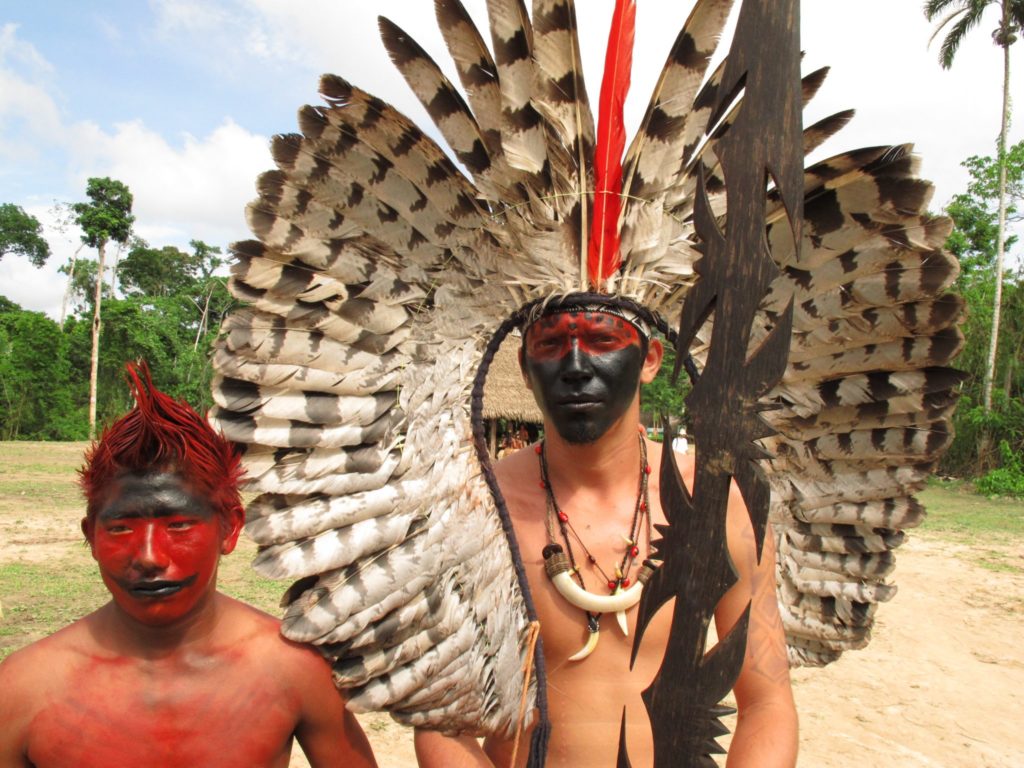
Join Me at the World Ayahuasca Conference
If you are intrigued by Amazonian culture and want to experience visionary medicines like ayahuasca, rapé, kambô, then join me for the World Ayahuasca Conference in Rio Branco, Brazil – which takes place the week before the Yawanawá Festival – and I will personally introduce you to amazing shamans and medicine makers. Here’s how:
Buy your tickets here & use the coupon code ENTHEO for a 15% discount.
View the World Ayahuasca Conference Speaker lineup here.
Check out the World Ayahuasca Film festival entries here.
Fun side events include hot air ballooning and the Yawanawa Festival – details here.
Are You Going to the Yawanawá Festival?
Please share your questions and thoughts in the comments below!
